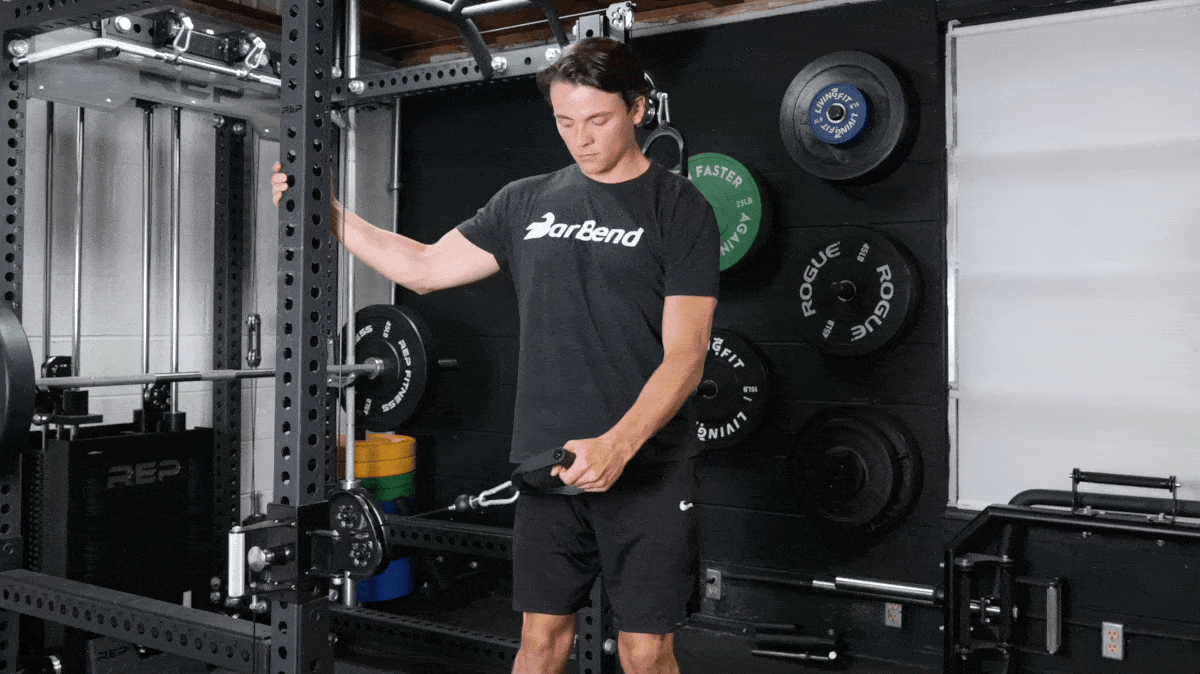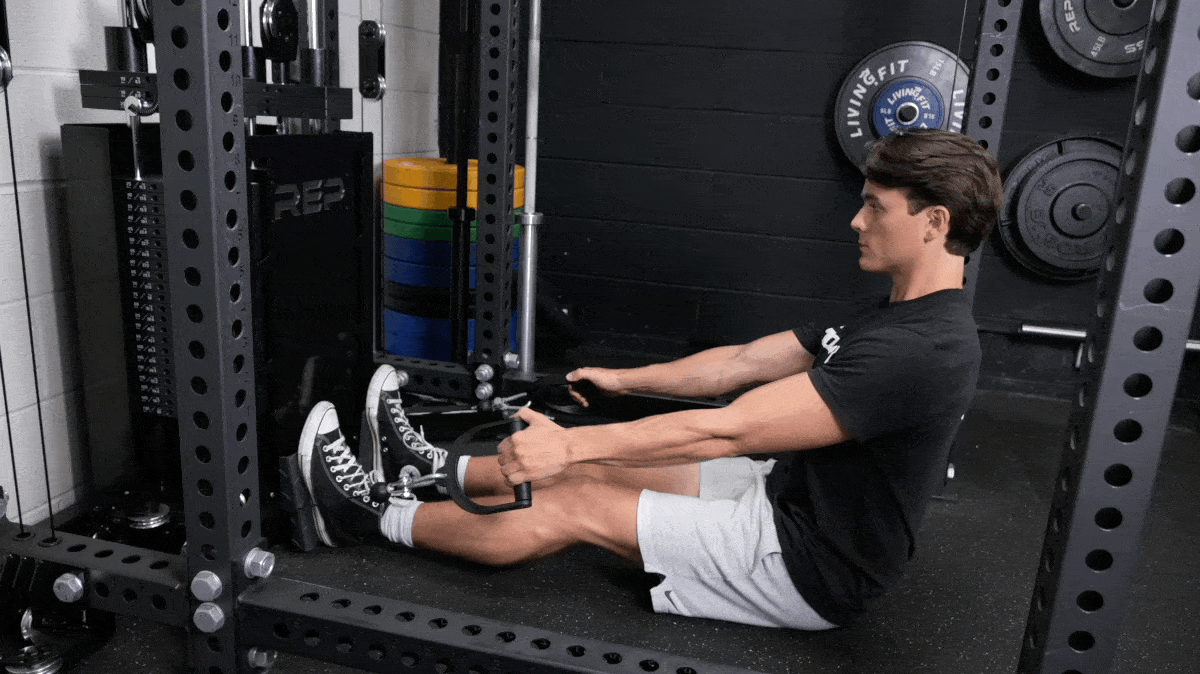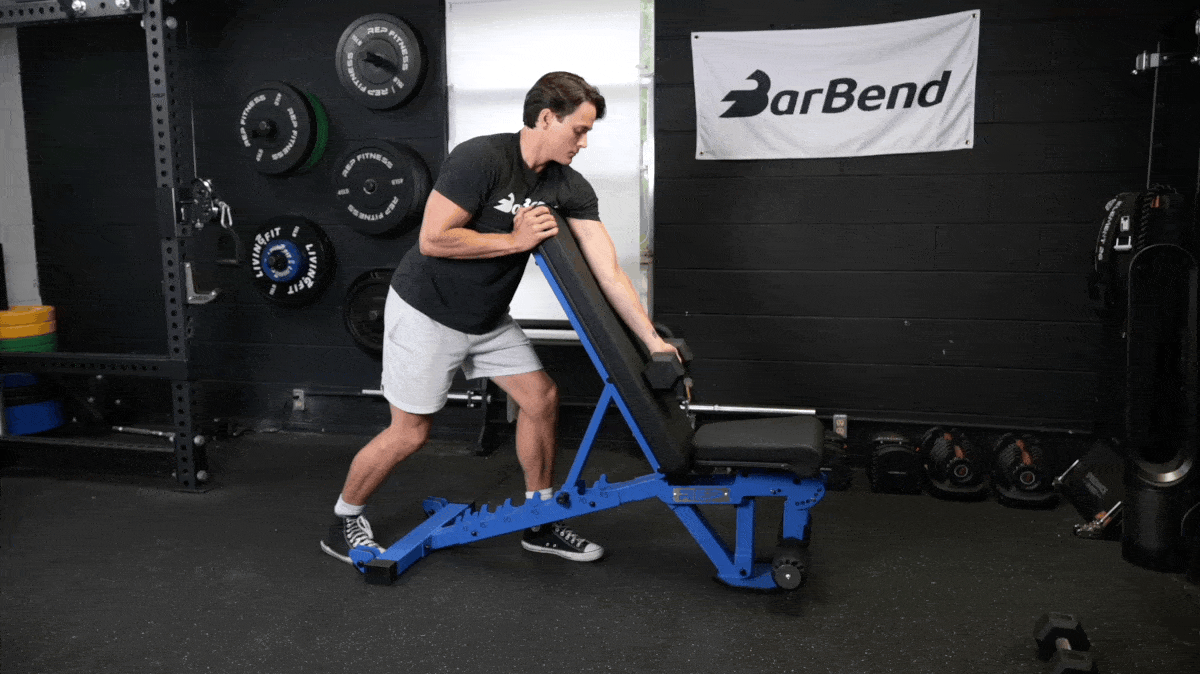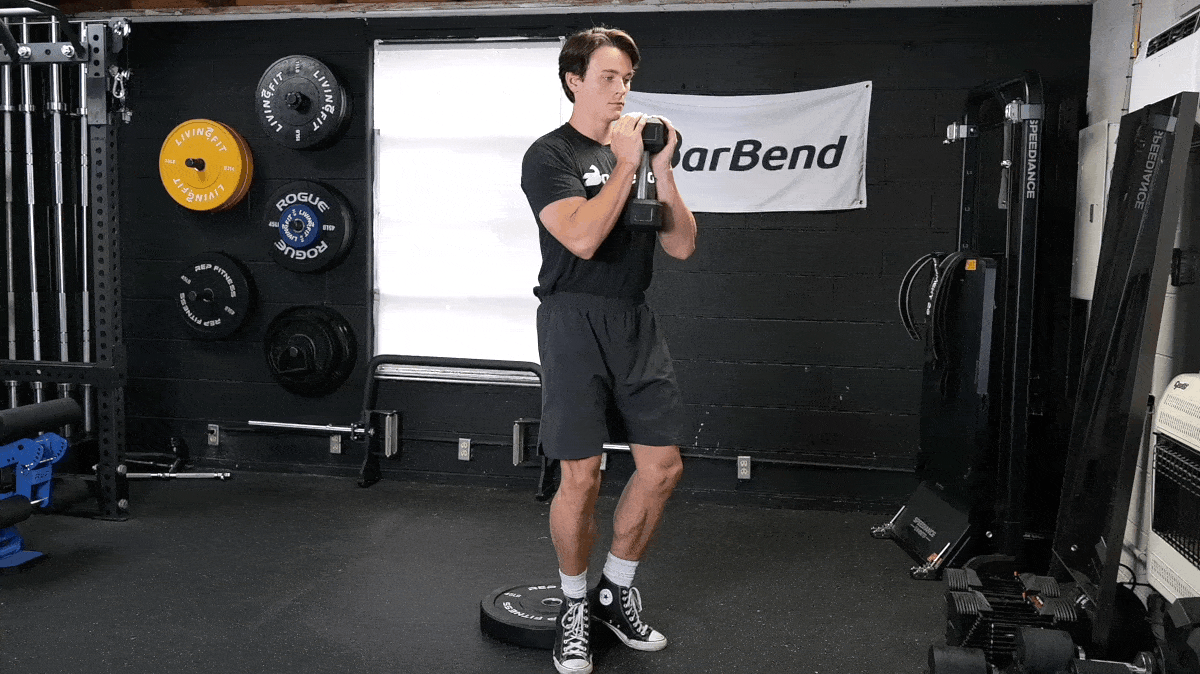The bodybuilding world is abuzz right now. Exercise science researchers and content creators alike may have struck muscle-building gold. Long-length partial reps, or LLPs, are the talk of the town.
New studies seem to be coming out left, right, and center saying that long-length partial reps might be the best way to build muscle — better, even, than using a full range of motion in some cases.

The jury may still be out, but long-length partials are definitely in. And you can start utilizing them during your own workouts right away, if you know what they are and which exercises are best suited to the technique. Start with this list and see for yourself if long-length partial reps really are muscle-making magic:
Editor’s Note: The content on BarBend is meant to be informative in nature, but it should not be taken as medical advice. When starting a new training regimen and/or diet, it is always a good idea to consult with a trusted medical professional. We are not a medical resource. The opinions and articles on thi site are not intended for use as diagnosis, prevention, and/or treatment of health problems. They are not substitutes for consulting a qualified medical professional.
What Are Long-Length Partial Reps?
Every strength training movement you perform in the gym is powered by a muscular contraction. When you begin a barbell curl, your biceps brachii starts fully stretched out and gradually shortens to bend your elbow.
Repeating the first half of that barbell curl — bending your elbow until your forearm is parallel to the ground but no higher — would be considered a long-length partial rep; you’re cutting out the portion wherein the target muscle is fully contracted.
An exercise’s “strength curve” refers to how its difficulty is distributed across the range of motion. Many movements are easy in the first half of the range of motion and hard later on (think bent-over row variations), or vice-versa (think deep squats).
Exercises with inconsistent strength curves are prime candidates for long-length partial repetitions because they allow you to truly exhaust the target muscle, rather than arbitrarily ending the set because you can’t move your arm or leg far enough. Mind that the effect of LLPs on hypertrophy is an emerging area of exercise science research, and experts have yet to come to an agreement on how to best utilize this technique.
The Science
There is a small collection of scientific papers that have analyzed the efficacy of long-length partial rep training compared to both shortened partials (the portion of range of motion where the muscle is mostly contracted) and standard full-ROM movement. Here’s what the science currently has to say about lengthened partial reps:
- The leading paper on the topic is a 2023 meta analysis by Wolf et al., which asserted that, “there may be a muscle hypertrophy benefit to partial ROM training at long muscle lengths compared to using a full ROM.” (1)
- That same Wolf study also noted that the magnitude of difference between doing LLPs and standard full-ROM training is “trivial to small.” (1)
- This study on leg extension ranges of motion showed that long-length partials “promoted greater relative hypertrophy in certain regions.” (2)
- One study on loaded calf training demonstrated that long-length partial reps produced more than double the muscle hypertrophy than full-ROM training. (3)
- Similarly, this study on the preacher curl showed that emphasizing the bottom half of the movement “promoted greater distal biceps hypertrophy” than doing the full range of motion. (4)
10 Best Exercises for Long-Length Partials
- Cable Lateral Raise
- Decline Reverse Crunch
- Pec Deck
- Seated Cable Row
- Leg Curl
- Dumbbell Pullover
- Preacher Curl
- Overhead Triceps Extension
- Cyclist Squat
- Smith Machine Bench Press
How to Use Long-Length Partials
The following 10 movements cover just about every major muscle group in your body. They’re particularly well-suited to working with long-length partial reps because of the inherent stability and the extreme levels of stretch they apply to the target muscle or muscles.
You can perform long-length partials with these moves in a handful of different ways:
- As a standalone own set, doing only long-length partial reps.
- As an intensity technique, performing a handful of long-length partials after your full-ROM reps.
- Scattered throughout your full-ROM set, doing a long-length partial rep between each regular rep.
1. Cable Lateral Raise
The standard lateral raise is one of the only ways to target the medial portion of your shoulders. To build your V-taper, you need to do lateral raises — but the dumbbell lateral raise variation has a pretty inconsistent strength curve.

[Read More: 4 Times You Might Want to Use Partial Reps]
At the bottom, when the deltoid is stretched the most, there’s almost no tension. Head to the cable station instead to fix this issue and build those boulder shoulders.
- Stand parallel to the cable tree with your working arm drawn across your body holding onto a handle that has been set between knee and waist height.
- From here, lift your arm up and outwards, keeping your elbow straight, until your upper arm is roughly parallel to the floor.
- Perform full-ROM reps until you can no longer lift your arm up to shoulder height.
- Continue to perform the bottom half of the exercise for additional repetitions.
2. Decline Reverse Crunch
Your abdominals are a muscle like any other; they respond to the same stimulation that grows and strengthens your pecs, biceps, or quads. However, most core exercises or workouts aren’t well-suited to long-length partials. However, you can do the decline reverse crunch and make some real headway on your six-pack.
[Read More: Improve Muscle Mass, Technique, and Mental Toughness With 1 ½ Reps]
- Set an adjustable bench to a 15 to 30-degree decline and lie down on it with your legs straight, hanging off the ends.
- Grip the edge of the bench behind your head tightly for support.
- Inhale, then lift your legs off the ground, curling your spine and pressing your lower back into the bench.
- Lift your legs up until your butt comes off the bench and your feet point toward the ceiling.
- Lower back down slowly, trying to unfurl your spine back down on the bench.
- As you fatigue, do the bottom half of the move only, lifting your legs up just until your tailbone comes off the bench.
3. Pec Deck
Horizontal shoulder adduction (in plain terms, drawing your arms out to the side) maximally stretches the pecs. This can be a dicey position to engage with if you do the dumbbell flye variation of the chest, but the pec deck machine offers more support in that end-range position. This makes it an ideal chest exercise for long-length partials.
[Read More: 3 Partial Range Of Motion Lifts To Boost Your Powerlifting Game]
- Adjust the seat height of the pec deck station so the handles are at level height with your shoulders. Set the handle arms out wide such that when you grab each handle, your arms are roughly parallel.
- With mostly straight arms, contract your pecs and push the handles toward each other. Think about driving your arms against the sides of your torso.
- As you fatigue, perform only the bottom half of the motion, moving your arms between the starting position and roughly 45 degrees.
- On your final rep, perform an isometric hold with your arms out wide. The plates of the station should be just barely picked up off the stack.
4. Seated Cable Row
The seated cable row is a fantastic lat exercise…and that’s before you incorporate some long-length partial reps into the mix. Like most pulling exercises, the seated cable row is easy at the start and insanely difficult at the end of the range motion. This means you still have a lot of juice left to squeeze once you can’t bring the handle all the way to your body.

[Read More: Learn the Single-Arm Cable Row for a Strong, Symmetrical Back]
- Affix a D-handle (or your attachment of choice) to the seated cable row station and place your feet against the pads.
- Sit upright and row the handle towards your sternum, pausing for a moment at the end to squeeze your back.
- As you approach failure and can no longer pull the weight until your elbows are in line with your torso, continue to perform partial reps, fully lengthening your arms out in front of you and pulling as far as you’re able.
5. Leg Curl
Leg curls are one of the best lower-body exercises for bodybuilding you can do. The leg curl machine allows you to isolate your hamstrings without stressing your lower back. As a bonus, the machine is well-suited for some long-length partials due to the consistent tension throughout.
[Read More: How to Nail the Lying Leg Curl to Build and Sculpt Your Hamstrings]
- You can do long-length partials with both the prone leg extension machine and the traditional seated variation.
- Situate yourself into the machine such that your knees just barely hang over the edge of the pad and the foot pad is against the back of your ankles.
- Perform leg curls until you can’t bring your feet all the way up.
- Then, move into lengthened partials by contracting your hamstrings to bring the pad up halfway at most.
- Lower it down with a slow tempo each time. As you fatigue, your range of motion should naturally shrink.
6. Dumbbell Pullover
The dumbbell pullover is a golden-era classic exercise for a reason. It’s one of the few moves that engages your chest, lats, and triceps all at once.
[Read More: Learn the Cable Pullover for Developing Bigger Lats and Stronger Pulls]
Moreover, the pullover is hardest when your lats are maximally stretched — exactly what you want for muscle-building.
- Lie down on your back on a flat weight bench while holding a dumbbell over your head.
- Clasp the dumbbell by the edges of the plates rather than holding it by the handle.
- With straight but unlocked arms, slowly lower the dumbbell back behind your head until your upper arms are parallel with the bench.
- For long-length partial reps, contract your lats to pull the dumbbell back only until it barely enters your field of vision.
7. Preacher Curl
The preacher curl was the movement of choice for one of the studies analyzing the potency of long-length training for hypertrophy. (4) The study made clear that long-length partials work just as well as full-ROM, particularly on bicep curl variations like the preacher where tension really drops off after the midpoint.

[Read More: How to Do the Concentration Curl for Bigger Biceps]
- If you don’t have a preacher curl bench, you can set an adjustable bench between 45 and 60 degrees and use a dumbbell instead of a curl bar.
- Start at the top and slowly lower the bar down until your arm is almost completely straight.
- Curl the weight up until your forearm is at least perpendicular to the bench. As you fatigue, do partial reps at the bottom, performing only the first third of the range of motion.
8. Overhead Triceps Extension
In mid-2022, a scientific study (5) was published whose findings indicated that overhead triceps extensions can build substantially more muscle than the triceps pressdown. The authors theorized at the time that the 40-percent margin in growth was due to lengthened tension.
The overhead triceps extension is ripe for applying some long-length partials due to the extreme stretch on the triceps brachii while your arm is suspended behind your head.
- Attach a rope handle, straight bar, or V-bar attachment to a cable station that has been set at roughly waist height or slightly lower.
- Stand away from the cable while holding the attachment in your hands. Twist your body around so you’re facing away and allow your arms to drift up behind your head, like you’re about to draw a sword from behind your back.
- Extend your elbow such that your arm forms a straight line pointing at the ground. Keep your upper arm firmly in alignment with your ears.
- As you fatigue, straighten your arm only until your forearm is parallel to the floor. That’s a long-length partial overhead triceps extension.
9. Cyclist Squat
Squats are the full package when it comes to bodybuilding leg workouts. Whether you do a squat variation or the mainline movement itself (the barbell back squat), you’ll be working most of the major muscle groups in your lower body.

The high heel elevation required for the cyclist squat further lengthens your quadriceps, making them a great choice for long-length partial reps without having to use ultra-heavy weights.
- Stand with your feet very close together and your heels elevated on a 1-2” surface the edge of a bumper plate.
- Place a lightly loaded barbell on your back or hold a medium-weight dumbbell in the goblet position.
- Unlock your knees and attempt to sit straight downward, maintaining as close to a vertical torso as possible the whole way.
- Sink down until your hamstrings compress against your calves and allow your knees to travel as far forward as needed.
- To do partial reps, contract your quads and stand up halfway; don’t return to a standing position until the end of the set.
10. Smith Machine Bench Press
Don’t scoff at it — the bench press is one of the best bodybuilding exercises you can do in the Smith machine, particularly if you’re trying to bang out some long-length partial reps. There’s an artful way to fail your set on the standard bench press, but there’s nothing to be gained by doing so. Head to the Smith for some added stability and safely take your sets to true failure.
- Place a flat bench in the Smith machine and set the bar into the hooks at just short of arm’s length.
- Lie down on the bench such that the bar falls directly above your collar bones.
- Unlock the bar from the bench and lower it down until it touches your chest. Keep your elbows directly under the bar at all times.
- Perform full-ROM reps of the Smith machine bench press until you struggle to lock out your elbows.
- Then, continue to perform long-length partial reps by touching your chest with the bar and coming up about half way. When you hit muscular failure, hook the bar back into the rack and slide out from under it.
References
- Wolf, Milo & Androulakis-Korakakis, Patroklos & Fisher, James & Schoenfeld, Brad & Steele, James & Wolf, M & Steele,. (2023). Partial Vs Full Range of Motion Resistance Training: A Systematic Review and Meta-Analysis. 3. 10.47206/ijsc.v3i1.182.
- Pedrosa, G. F., Lima, F. V., Schoenfeld, B. J., Lacerda, L. T., Simões, M. G., Pereira, M. R., Diniz, R. C. R., & Chagas, M. H. (2022). Partial range of motion training elicits favorable improvements in muscular adaptations when carried out at long muscle lengths. European journal of sport science, 22(8), 1250–1260.
- Kassiano, W., Costa, B., Kunevaliki, G., Soares, D., Zacarias, G., Manske, I., Takaki, Y., Ruggiero, M. F., Stavinski, N., Francsuel, J., Tricoli, I., Carneiro, M. A. S., & Cyrino, E. S. (2023). Greater Gastrocnemius Muscle Hypertrophy After Partial Range of Motion Training Performed at Long Muscle Lengths. Journal of strength and conditioning research, 37(9), 1746–1753.
- Pedrosa, G. F., Simões, M. G., Figueiredo, M. O. C., Lacerda, L. T., Schoenfeld, B. J., Lima, F. V., Chagas, M. H., & Diniz, R. C. R. (2023). Training in the Initial Range of Motion Promotes Greater Muscle Adaptations Than at Final in the Arm Curl. Sports (Basel, Switzerland), 11(2), 39.
- Maeo, Sumiaki & Wu, Yuhang & Huang, Meng & Sakurai, Hikaru & Kusagawa, Yuki & Sugiyama, Takashi & Kanehisa, Hiroaki & Isaka, Tadao. (2022). Triceps brachii hypertrophy is substantially greater after elbow extension training performed in the overhead versus neutral arm position. European Journal of Sport Science. 1-26. 10.1080/17461391.2022.2100279.
Featured Image: nazarovsergey / Shutterstock